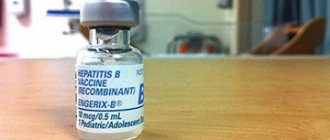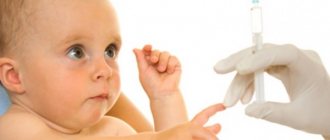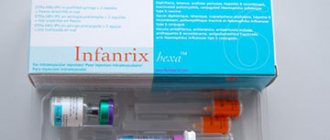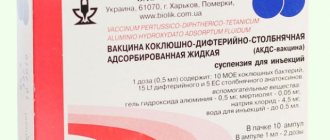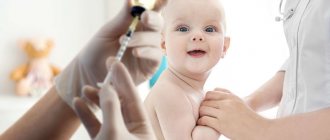Why is vaccination done?
Used in the following cases:
- For planned diphtheria and tetanus booster doses at ages 7 and 14 years;
- As a replacement for DPT for children experiencing acute general reactions to it;
- For vaccination of adults and children over 7 years of age, including those who have never been vaccinated before.
Let's look at each of these cases in detail.
Who invented vaccinations?
“Treat like with like” - have any of our readers come across this principle? Surely many people know that this is about homeopathy.
But this is not about her. Try to imagine what else could be said using this approach? Let's not languish: with some assumption - about vaccinations.
“What does something like this have to do with it?” - you ask? Let's find out.
Ancient, even more ancient...
Immediately the question is: what do a vaccine and... a cow have in common? Hint: the Latin word for “cow” is “vacca”. It is from this word that the term “vaccine” originates. It was proposed by the French microbiologist and chemist Louis Pasteur. He did this in honor of the doctor Edward Jenner, known in the world of medicine and in the history of vaccination as the creator of vaccine prevention.
Edward Jenner
The 18th century was drawing to a close. Jenner, while in the village, noticed that farmers who farm cows infected with cowpox do not get smallpox, a terrible infectious disease that “mowed down” millions of people when the epidemic occurred.
Apparently, the doctor made a connection between these facts and decided to inoculate the boy with cowpox. After a bold experiment, the boy also became resistant to this infection.
AGAINST THE BACKGROUND OF EPIDEMIOLOGICAL WELFARE, PEOPLE OFTEN REFUSE VACCINATIONS. AS A RESULT, INFECTIONS THAT WERE CONSIDERED ERADICATE ARE RETURNING
At that time, representatives of the microworld had not yet been studied. The method itself is widely distributed throughout Europe, and later, thanks to it, smallpox is eradicated on a global scale.
A century later, Jenner's idea was developed and improved by Louis Pasteur, who later created a vaccine against rabies.
Read the material on the topic: Living according to your dreams. The great discovery of Louis Pasteur
So it's the 18th century? As it turned out, not quite so. Long before Jenner and Pasteur, so-called inoculation was carried out in India and China - inoculating healthy individuals with liquid from the blisters of patients with a mild form of smallpox. The technique was far from perfect: the virus, although less dangerous, sometimes still led to death. In addition, it also happened that a highly pathogenic pathogen was mistakenly introduced. Later, a similar principle of grafting began to be practiced in Europe and America.
At the beginning of the 18th century, one of the methods of protection against smallpox was brought home from Turkey by the wife of the English ambassador.
Despite the positive reviews, few dared to use the “Turkish protection”: no matter how obvious the benefits of such a “vaccination” were, people were very afraid of getting sick with “real” smallpox. Nevertheless, there were brave men, including persons noted by the authorities.
Our country is also mentioned in the early history of vaccination. At the end of the 60s of the 18th century, the English doctor T. Dimsdal visited Russia. He was invited to administer smallpox vaccinations to Catherine II and her son Paul.
Read material on the topic: Catherine the Great: healthcare organizer, pediatrician and teacher
Thus, the idea of preventing like with like was, as they say, “in the air,” and Jenner was able to catch the “smell” of it.
Another interesting fact. A little more than 20 years before Jenner’s experience, which went down in medical history, an English farmer infected his wife and two of his children with cowpox. The neighbors were indignant. All three began to feel feverish, so a doctor's visit was necessary. However, when a smallpox epidemic occurred in the area, the farmer’s family members were not harmed, even though they had contact with the sick. In the early 90s of the same century, the Englishman’s experience was repeated by his Prussian “colleague,” also a farmer.
So who created the vaccines? As you can see, answering this question is not so easy. However, it was thanks to Jenner’s work that vaccine prevention became widespread. Its principles were later picked up and developed by other scientists.
What happens to the immune system when an infection enters the body: from disease to vaccine prevention
Once a pathogen enters, the cells of the immune system react to it. The components of the agent that are perceived by the body as foreign and cause a specific response from the immune system are called antigens. The products of the immune response are antibodies and immune cells that can attack the infectious agent.
After its elimination, the “trained” immune system remains ready for a new encounter with the infection - with the difference that the next time it will respond immediately to the introduction of a microorganism.
Apparently, the same principle of protection was intuitively used by Jenner’s predecessors - with the difference that they took a cow rather than a human pathogen. Jenner himself wrote that these two varieties of smallpox are two forms of the same disease, and the transfer of cowpox makes one resistant to smallpox.
THE LAST CASE OF NATURAL SMALLPOX INFECTION WAS RECORDED IN SOMALIA IN 1977
A natural question may arise: isn’t such a “frontal” approach to creating immunity to infections in general too risky? If you think about it: a sick person releases pathogens that, when entering the body of another, are likely to cause illness. But this is no longer a vaccination, but a relapse in the literal sense of the word. And then: in the case of farmers and Jenner, the vaccination was done not with a human, but with a cow pathogen. Fortunately, it also caused protection from human ones. But what about other microorganisms, the “relatives” of which, relatively safe for humans, cannot be found in animals?
Change but keep
At the beginning of the 20th century, methods for the stable weakening of pathogens appeared. This eliminated the risk of disease, but retained the effect of creating protection.
Scientific progress has made it possible to obtain vaccines that can be divided into three groups:
- alive. Contain a weakened pathogen that cannot cause disease, but stimulates the immune system;
- inactivated. Contain a killed pathogen or parts thereof;
- toxoids - bacterial toxins in a modified, harmless form.
Further developments in the field of molecular biology and genetic engineering made it possible to create molecular vaccines that contain certain proteins or protein fragments of pathogenic pathogens.
Read the material on the topic: Are unvaccinated children the healthiest?
DNA vaccines. The principle of their operation is as follows. It is not the pathogen itself (weakened or killed) or its antigens that is introduced into the body of a person who is about to be vaccinated against any infection, but a section of its nucleic acid. A specially selected area is one along which the desired antigen protein is formed. In other words, a carrier is introduced in which information about the antigen is encoded. Once in a human cell, this nucleic acid begins to produce the necessary proteins. These vaccines are in the research stage. There are other approaches to vaccine technology.
After vaccination
Once in a previously vaccinated body, the pathogen has no chance, since the attack begins as early as possible after its penetration. Therefore, the body either will not get sick at all, or will suffer a mild form of the disease and without complications.
Practical results
Those of our readers who were born in the late 70s and later probably no longer have traces of the smallpox vaccine. Do you know why?
The last case of natural smallpox infection was recorded in Somalia in 1977. The next case was the last case of laboratory infection. And in the 80s it was announced that this infection had been eliminated. In the Soviet Union, vaccination was stopped in 1978-1982. Thanks to vaccinations, polio was completely eradicated in the United States by the end of the 70s.
Read the material on the topic: Polio is coming back?
Millennium
We all like closure on problematic issues. The total eradication of smallpox is one of these. However, in the early 2000s, US President George W. Bush ordered a vaccination campaign against smallpox among all military personnel. The reason is the distribution of anthrax spores (one of the most dangerous infections) and the threat of using smallpox as a biological weapon.
THANKS TO VACCINATIONS, BY THE END OF THE 70'S POLIOMYELITIS WAS COMPLETELY ELIMINATED IN THE USA
To date, only a few laboratories around the world are working with variola virus for research purposes.
Is it just an infection? Is it just prevention?
As it turns out, no. Today, vaccines are being developed for the treatment of chronic infectious pathologies (in particular, those caused by hepatitis B and C viruses, papilloma, human immunodeficiency), neoplasms (melanoma, breast or colorectal cancer), allergic or autoimmune diseases (multiple sclerosis, type I diabetes, rheumatoid arthritis).
When leaving, the disease looks back
Even if the present and future generations do not have to face the devastating epidemics of the past, the current situation is also far from ideal. Some respiratory tract infections, viral hepatitis B and C, tuberculosis, malaria, as well as relatively recently emerging threats in the form of the Ebola virus, HIV, coronaviruses and a number of other pathogens still pose a danger.
The situation is complicated by the fact that, against the backdrop of epidemiological well-being, people often refuse vaccinations. As a result, infections that were thought to be eradicated return.
IN THE MID-90s, AN OUTBREAK OF DIPTHERIA OCCURRED IN RUSSIA. AS A RESULT OF THE ANTI-VACCINATION CAMPAIGN, MORE THAN 100 THOUSAND WERE INFECTED. PEOPLE, SEVERAL THOUSAND OF THEM DIE
Over the past few decades, diseases of whooping cough, diphtheria, polio, and measles have been reported in Japan, Russia and some other CIS countries, and in certain Latin American countries. In 2011, almost all US states did not provide the required number of whooping cough vaccinations. As a result, 42 thousand people fell ill the next year. In the mid-1990s, Russia experienced an outbreak of diphtheria, which had previously only occurred occasionally. As a result of the “anti-vaccination” campaign, more than 100 thousand people became infected, several thousand of them died. The epidemic was stopped only thanks to mass vaccination of children.
Warn? Yes! Current state of the issue
To date, a national vaccination calendar has been developed and is in effect. It regulates the frequency of vaccination of children depending on their age. The calendar includes vaccinations against infections such as viral hepatitis B, tuberculosis, polio, whooping cough, tetanus and a number of others.
Here's what the calendar looks like today:
Afterword
The progress of medicine in the field of prevention of dangerous infections makes it possible to avoid infection with them, or to suffer from a mild form of the disease. National vaccination calendars are periodically updated and supplemented. Largely thanks to vaccination, society is free from epidemics of one or another infection. Therefore, is it worth playing dice with fate by refusing vaccinations?
Text: Enver Aliyev
Instead of DPT
Such vaccinations are given a little less often to children who have a strong reaction to DTP antigens: temperature 40° and above, allergic rash, Quincke's edema and convulsions. If such side effects are observed after the first injection of DPT, the second and subsequent vaccinations can be given with ADS-M.
The ADSM vaccination is tolerated much more easily by children, without temperature fluctuations or other complications. There is no anti-pertussis component in ADS-M, so if necessary, it is given as a separate injection.
DTP vaccine: why it is given in the thigh, and what reactions there are to it
The adsorbed pertussis-diphtheria-tetanus vaccine protects the child from three dangerous infections: whooping cough, diphtheria and tetanus. According to modern standards, this vaccination is given only in the leg (thigh), and there are two very good reasons for this. Firstly, in a person’s buttocks there is a sciatic nerve, which is extremely undesirable to hit with a syringe needle. Secondly, it has been proven that the effectiveness of the vaccine is higher when it is administered specifically into the thigh muscle, since when vaccinating into the buttock, especially if the baby is well-fed, there is a high probability of the drug getting into the fat layer instead of muscle tissue, which makes it difficult to absorb the vaccine, and this leads to reducing the effectiveness of vaccination.
Diphtheria and tetanus toxoids included in the vaccine are easily tolerated by children, and the killed pertussis microbes contained in the drug are responsible for responses to DTP. Today, however, a purified vaccine has already been developed and has proven itself to be excellent, in which pertussis microbes undergo special treatment and no longer cause any adverse reactions, but such a vaccine is many times more expensive, and therefore is not used in our country for free vaccination.
The most common reactions to the DPT vaccine are fever, tearfulness, loss of appetite, as well as hardness at the injection site that does not go away for a long time, and pain in the “injected” leg. Less commonly, swelling and redness of the thigh where the injection was given develops.
Vaccination of adults
For adults, they prefer to receive a lighter version of the diphtheria-tetanus vaccine, without the anti-whooping cough component - the danger of whooping cough practically disappears with age, which cannot be said about tetanus and diphtheria.
Vaccination of adults in this case is carried out with two vaccinations with an interval of 30 days and one revaccination after six months or a year and a half.
Vaccination abbreviations and their interpretation
Vaccination is a process in which antigenic material is introduced into the body to produce antibodies to certain diseases. Patients are given a referral for immunoprophylaxis. The vaccination performed is recorded in a special document. The names of vaccinations in medical papers are usually abbreviated.
So, in a card or direction you can see the following abbreviations:
- DPT;
- ADSM;
- PPP;
- HBV;
- HAV;
- BCG;
- PDA;
- DST;
- PME;
- PPM;
- OPV;
- IPV;
- GIB;
- ZhPV.
It is important to be able to decipher vaccination abbreviations: the patient must be fully aware of what pathologies he is being immunized against.
DPT AND ADSM
DTP is an adsorbed pertussis-diphtheria-tetanus vaccine. Contains toxoids and attenuated cells of pathogens. Immunization is carried out from the age of three months.
Vaccination protects against the following diseases:
- whooping cough The first symptoms of this pathology are similar to the flu or a cold. Whooping cough manifests itself as high fever, cough with sputum, and runny nose. The patient's condition is getting worse every day. The cough becomes paroxysmal in nature, may be accompanied by hemoptysis, vomiting, and lead to respiratory arrest;
- diphtheria . Bacteria of this pathology secrete a strong poison that poisons all organs and systems. Most often the liver, heart, and kidneys are affected. Often the causative agent of diphtheria is localized in the larynx and throat. Severe inflammation and swelling can cause asphyxia and death;
- tetanus _ Despite the development of medicine, today there are still no effective cures for this pathology. Bacteria attack the spinal canal and lead to seizures. If the causative agent of tetanus affects the respiratory organs and causes them to spasm, then death occurs.
These diseases are considered highly contagious. Children under two years of age are especially susceptible to them. ADSM is an adsorbed diphtheria-tetanus vaccine . The drug contains half the dose of toxoids than DTP. Suitable for immunization of weakened children and adults.
ADSM vaccine
DPT, ADSM are domestically produced drugs. To protect against infection with dangerous viral and bacterial pathologies, imported products Pentaxim and Tritanrix NV are also used.
PPP
TPP is a vaccine against polio. Depending on the type of drug used, vaccination can be carried out with a live or inactivated agent. Poliomyelitis is a highly contagious disease of the nervous system. The virus attacks the gray matter of the spinal cord and causes paralysis.
After suffering a pathology, a person may remain disabled for life. Therefore, TPN is the only method of preventing infection with the polio virus. Vaccination begins at three months of age.
Vaccine Imovax Polio
Today, the following drugs are used to protect children and adults from polio:
- Poliorix;
- Infanrix IPV;
- Imovax Polio;
- Oral polio vaccine;
- Pentaxim;
- Tetrakok.
HBV and HAV
HBV is a vaccination against the hepatitis B virus. HBV vaccination is included in the list of mandatory ones. The hepatitis B virus attacks the liver, causing inflammation and cell destruction. Often the disease leads to cirrhosis and cancer.
The pathology is especially dangerous for children: in 50% of cases, hepatitis suffered in infancy becomes chronic. Therefore, people begin to be vaccinated against infection with such a virus from birth.
Vaccine Regevak B
The following drugs are used for prevention:
- Regevak B;
- Engerix;
- Bubo-Kok;
- Eberbiovac;
- Euvax.
HAV stands for hepatitis A vaccination. The disease is characterized by liver damage. In Russia, hepatitis A virus is not particularly common. Therefore, immunization is optional.
Prevention is recommended for the following categories of the country's population:
- military personnel;
- medical staff;
- food service workers;
- patients with chronic liver pathologies;
- employees of educational and educational institutions;
- drug addicts.
The following vaccines are used to protect against hepatitis A virus:
- Algavac M;
- Avaxim;
- Havrix.
The first drug to protect against hepatitis B infection was created in 1982, but mass vaccination began only in 2002.
BCG
BCG is an abbreviation that is written in Russian letters and is a tracing paper of the Latin letters BCG. Stands for bacillus Calmette-Guerin (Calmette-Guerin bacillus) . You can also find BCG - this is an abbreviation of the name of the vaccine translated into Russian.
BCG is one of the first vaccines given to newborns. Prevention is carried out to protect against tuberculosis. This disease is quite common in the country and is considered highly contagious. Therefore, immunization is mandatory.
Tuberculosis is an infectious pathology characterized by damage to the lungs. Sometimes bacteria affect the nervous and genitourinary systems, and the musculoskeletal system.
Pulmonary tuberculosis is manifested by cough with sputum, fever, fatigue, tachycardia, chest pain, shortness of breath, and sudden weight loss. Pathology can cause internal bleeding and pneumothorax.
There is also the BCG-M vaccine. This is a complete structural analogue of BCG, which contains half the dosage. This drug is used for weakened individuals.
PDA
MMR is a vaccine that protects against rubella, mumps and measles . These are highly contagious pathologies. Children under ten years of age are most often infected with them.
Rubella is a disease that in some cases occurs in a mild form. The main symptoms are fever, rash on the body, and swollen lymph nodes.
Mumps is a disease in which the virus attacks the glandular organs (testes, pancreas and salivary glands). Sometimes the central nervous system is also involved in the pathological process.
Measles is a viral disease that manifests itself as hyperthermia, sore throat, cough, rash on the body, and general poor health. Pathology leads to damage to the blood vessels and capillaries of the eyes. As a result, the infected person experiences photophobia.
All three pathologies are dangerous in their consequences. For example, mumps can lead to male infertility, measles - to polyneuritis, bronchopneumonia, encephalitis, rubella - to pneumonia, thrombocytopenic purpura. MMR vaccination begins at one year of age. Domestic and foreign drugs can be used for immunization.
Priorix vaccine
The following vaccination products are registered in the country:
- GIB;
- ZhPV;
- Ruwax;
- Priorix;
- Ervevax;
- Rudivax;
- MMR-II.
DST
DST stands for Diaskintest . Many people consider DST a vaccination. But this is more of a diagnostic method. Like the Mantoux test, Diaskintest is designed to detect the presence of antibodies to tuberculosis, a latent form of pathology.
This research method is considered more informative and accurate. The drug for performing DST contains synthetic antigens CFP10, ESAT6. When the drug is introduced into the body, a response occurs.
The result is assessed after a few days. If the infiltrate is less than 5 mm, this means that there is no bacterial infection. When the papule is 5-14 mm, then infection occurs. Moreover, the larger the spot, the higher the likelihood of tuberculosis.
Other abbreviations for vaccines for children and adults
In the medical record of a child or adult, you can also find other abbreviations:
- MAP is a vaccination against meningococcal infection. Bacteria can cause inflammation of the membranes of the brain and spinal cord. Meningitis develops quickly, with an increase in intoxication and neurological signs. In some cases, the pathology ends in death;
- LCV is a live measles vaccine. It is a one-component drug containing a weakened virus. LPV stands for live mumps vaccine;
- OPV is the oral polio vaccine. The drug contains a live attenuated virus. Available in the form of oral drops. The liquid has a bitter-salty taste. For children, the solution is dripped onto the tonsils. The advantage of OPV is that the integrity of the epidermal integument is not compromised during immunization. The disadvantage of vaccination is the possibility of developing vaccine-associated pathology;
- IPV . Stands for inactivated polio vaccine. The drug is available in injection form. The composition contains killed strains of three types of viruses. IPV is considered a safer vaccine than OPV.
In Russia, it is customary to start polio prevention with inactivated drugs and continue with live vaccinations.
Why is ADS-M better or worse?
First, it should be understood that ADS-M is no longer “whooping cough-diphtheria-tetanus”, but only the last two components. Many people, after vaccination at three months, are tempted to replace the complex and painful DTP with easier and safer ADS-M vaccinations for the second and third vaccinations.
This is highly discouraged: the child will be left without immunity to whooping cough and will receive weakened immunity to diphtheria and tetanus compared to the standard vaccine.
Many parents succumb to the misconception that “easier to tolerate means better.” But this is fundamentally wrong: the purpose of any vaccine is to create stress on the body’s immune system so that it develops an impregnable defense against a real uncontrollable infection. And if DTP copes with this task with a bang, then the purpose of ADS-M is rather to renew and maintain existing immunity - the effectiveness of immunity obtained in this way is much lower.
Unless there is a compelling reason to replace the vaccine, such as on your doctor's orders, you should not do so.
It is difficult for many to make such a choice, seeing how the baby suffered from fever after the first vaccination, but we should not forget how dangerous real infections are.
Another thing is really dangerous reactions, such as anaphylactic shock or neuralgic pathologies after injections. Here, the replacement of the drug is due to safety, when vaccination can lead to irreparable consequences. It is in such cases that children under seven years of age should replace the standard vaccine.
When the ADS-M vaccine is given to children from three to six months of age, it is a necessary measure, but not a “successful replacement” for a bad drug. Everyone should remember this.
Possible reaction to the DTP vaccine
The reason for the increased interest and much controversy is the specific reaction to the DTP vaccine after injection into the thigh. There is an opinion among parents that such a vaccination is less well tolerated and more often causes pain in the leg. In fact, there are several factors that influence tolerability and the incidence of complications:
- proper transportation of the drug to the vaccination room;
- maintaining temperature conditions during storage;
- general well-being of the baby, the presence of hidden inflammatory processes;
- the number of components in the vaccine;
- quality of nursing;
- proper treatment of the injection site, maintaining sterility of the instrument.
The DTP vaccine combines a whole group of drugs against serious diseases. In recent years, the ADS vaccine has been used, which does not contain antigens against whooping cough. This is the most allergenic component, increasing the risk of complications in the form of temperature, fever, and soreness.
List of vaccinations that are given to a child's hip
- Pentaxim with the addition of a vaccine against hemophilus influenzae and polio;
- Tetrakok, combining the standard DPT formula and polio;
- Tritanrix-NV, enhanced with antigens against hepatitis B;
- AC containing only anti-tetanus components;
- AD-m, which creates immunity only from diphtheria.
Why does the DTP vaccine most often cause a severe allergic reaction? In most cases, the complication is associated with a complex composition. The baby receives the first vaccine at the age of 3 months, when the innate immunity transmitted from the mother is maximally weakened. The entry of foreign viruses into the body provokes a natural response of the immune system, which often occurs with complications:
- The appearance of a dense lump up to 1–2 cm in size on the thigh. This is an accumulation of leukocytes at the injection site, which is considered natural when any virus or bacteria enters.
- Redness or rash due to an allergic reaction to a vaccine.
- Temperature rise above 38°C. Some children experience seizures, disorientation and other dangerous symptoms that require qualified help.
- Lameness or severe pain in the leg that makes it difficult to move. Doctors attribute the complication to the development of a local inflammatory process or improper administration of the vaccine. Sometimes the problem occurs when using a needle that is too large in diameter.
- Nausea or refusal to eat. The reaction is considered natural against the background of a febrile state.
In recent years, the ADS vaccine has been used, which does not contain antigens against whooping cough.
This is the most allergenic component, increasing the risk of complications in the form of temperature, fever, and soreness. Among the rare complications that occur with equal frequency after vaccination in the thigh or buttock of a child are the development of autism. If you are allergic to any of the components, the risk of angioedema, suffocation or damage to the respiratory system increases.
Vaccination schedule
The first DTP vaccination is given at three months, then at 4.5 and six months. This is the period of the first vaccination, at the same time an oral polio vaccine and against Haemophilus influenzae are given. The next injection is due at 18 months, then 6/7, 14, 24 years and then every 10 years.
Of the listed intervals, the schedule for ADSM vaccination is approved at 7 or 6 years, at 14 years and later. The remaining cases are private and should be considered individually, whether the child is intolerant to standard DPT or acute immunodeficiency.
Let's give a short vaccination schedule that concerns only ADS-M:
- At 4.5 months, it is permissible to replace DTP with this vaccine, after approval by the doctor.
- At 6 months, severe reactions after DTP are much more common, so at this age the drug is replaced more often.
- At 18 months it is the same - they are replaced in extreme cases, after consultation with a doctor.
- Routine vaccinations at 7 years of age are the first time that ADS-M is included in the vaccination schedule.
- The second revaccination at age 14 is also done only with ADS-M.
- Adults are vaccinated with this vaccine for 24 years and every subsequent 10 years.
Complications and contraindications
There are no permanent contraindications to the use of ADS-M vaccination for both adults and children.
Vaccination with the drug is not recommended for pregnant women due to a lack of clinical studies - how the vaccine affects the course of pregnancy is unknown.
In addition, there is a temporary contraindication common to all vaccines - recent acute illnesses. In severe cases of the disease, vaccinations are given several weeks after the last symptoms.
People with severe chronic diseases are vaccinated during a period of partial or complete remission. HIV or other immunodeficiency syndromes are not a contraindication to vaccination, but require special monitoring by doctors.
Before each vaccination, an immunologist or junior medical staff must check that there is no fever.
There are no other contraindications.
Consequences of vaccination
Negative consequences after the ADS-M vaccine are less common than after any other: due to the low antigen content, it has very low reactogenicity.
Most reactions after injection mean either weak immunity or the presence of some other negative processes in the body. This is especially true for adults - from the age of 14, revaccination with this drug should be absolutely painless and accompanied by only a slight increase in temperature for a day or less.
Despite the fact that serious complications after ADSM vaccinations are recorded less frequently than 3 cases per 100 thousand vaccinated, they should not be forgotten.
Let’s take a brief excursion to understand what is normal after vaccination with ADSM and what is not.
Which of the reactions are considered acceptable:
- short-term increase in temperature, no more than 39°;
- lack of appetite;
- diarrhea;
- vomiting in children;
- tiredness or drowsiness.
The mentioned symptoms are typical for both adults and children, but in the former they appear much more often and more vividly, especially in children 6 months and younger. All these symptoms are observed only during the first three days after immunization. Anything later cannot be associated with vaccination and is a symptom of a concurrently developed disease or chronic illness.
What can be considered serious consequences:
- A severe allergic reaction that does not go away for more than a few hours;
- Anaphylactic shock;
- Temperature above 39° for more than one day;
- Symptoms of encephalitis.
Fever and any other symptoms after vaccination can and should be removed. Antipyretics should always be in the arsenal of those who are going for vaccination, either themselves or with a child. What you shouldn’t do is panic at the slightest symptoms of a viral infection and run around hospitals with your child.
Injection site
In the final part of the article, we will look at how and where ADSM vaccinations are given, how painful it is and what remains after the injections.
ADS-M is available exclusively in the form of suspensions for intramuscular administration, no drops on the tongue like OPV or scratching like Mantoux.
Injections are given intramuscularly, in a place with low fat tissue. The outer surface of the thigh or the area under the shoulder blade is ideal for this. Since the ADSM vaccine contains aluminum hydroxide as a preservative, the injection site may become very sore and irritated.
Under no circumstances should you scratch or damage it, this will only make the situation worse. It is not always possible to explain this to a child, so apply a compress with cooling ointment or Panthenol. Otherwise, the child may constantly irritate the injection site, stop sleeping, and even scratch the bump until it bleeds.
As for the bump, it can reach 5 centimeters in diameter and not go away for a whole week. Use compresses, ointments and light massage of the area to speed up the healing and resorption of the lump. For children, an ointment that reduces pain, such as troxevasin, is ideal.
Why are vaccinations given in the thigh and not the buttock?
The anterolateral thigh area is the most preferred area for grafting. Why? The fact is that piercing in this place is the safest, since damage to large vascular structures and nerve formations is impossible, since they simply do not exist in this area of the thigh.
But the gluteal muscles in children are not used for vaccination due to:
- there is a high risk of puncturing the sciatic nerve. This is very painful and can paralyze the patient;
- the likelihood of touching the nerve trunks if they are abnormally located, which is diagnosed in 5% of children.
In addition, there is too much fat in the buttock area. This means that the injected suspension may not enter the muscle, but the adipose tissue.
In this case, the medicine will take a long time to dissolve, and an abscess is likely to form at the puncture site.
If a drug is prescribed for the procedure with intramuscular injection (that is, into the thigh or shoulder), make sure that the injection is placed exactly in the child’s leg. Do not rely on official (free) materials. Buy syringes with needles of suitable length in advance: for babies they use short and thin ones.
Doctor consultations
With this we have considered almost everything related to ADSM vaccinations and I would like to end with a classic warning - do not self-medicate and do not decide for doctors and scientists how and when to vaccinate.
A person is free to do whatever he wants with himself, but when it comes to defenseless children, it is better to trust doctors and science.
The vaccine we considered has almost no contraindications, but diphtheria antigen, as well as tetanus, are contained in too small a concentration to form 100% immunity. That is why this drug is used in rare and private cases or to maintain existing immunity, but not for widespread first vaccination.

